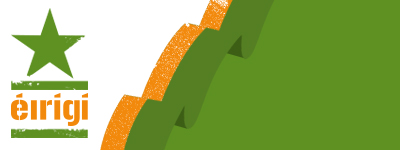The Giveaway Of Ireland's Wind Energy - Case Study: The Dublin Array
There is an energy revolution happening in Ireland. The days of near total reliance on imported fossil fuels are slowly, but steadily coming to an end. Over the next decade the demand for green electricity is going to rise dramatically as we move away from our reliance on coal, gas and oil for transport, heating, lighting, cooking, agriculture and industry.
Among the various sources of renewable energy that will meet an increased demand for green electricity, the wind is king. In 2019, 32.5% of all electricity consumption in the Twenty-Six Counties came from wind turbines. The equivalent figure in the Six Counties was even higher at circa 37%.
By 2030, it is anticipated that 70% of all electricity will be generated from renewable resources, with perhaps 90% of this figure coming from wind turbines.
This energy revolution is being driven by the need to combat man-made climate change - a topic that has, rightly, been discussed at great length over many years. But the pace of that revolution is being controlled by the private companies that have been gifted effective control of the energy sector by successive governments over several decades.
At no point during that time has there been a meaningful public discussion about the ownership of Ireland’s renewable energy sources - no discussion about who owns the wind and who stands to profit from harvesting it.
To highlight the giveaway of Ireland’s wind energy resources to private corporations, Éirígí For A New Republic is publishing a series of case studies about existing and planned wind farms. You can view the case study into the Arklow Bank Wind Farm here.
Today we look at the proposed the Dublin Array Wind Farm.
The Dublin Array would be 10km offshore, stretching from Booterstown in Co Dublin to Greystones in Co Wicklow. Image courtesy of The Irish Times.
Location: The Kish and Bray banks, located 10km from the Dublin / Wicklow shoreline stretching from Booterstown to Greystones.
Electrical Production: The completed project will consist of between 60 and 100 turbines capable of producing between 600MW and 1,000MW of engery. That’s enough energy to power between 480,000 and 800,000 homes for one year - the equivalent of up to one in every four homes in Ireland.
Ownership: The Dublin Array is being developed by a partnership between the German company Innogy and the Irish company Saorgus, with each company holding a 50% stake in the project. Innogy, which is a subsidiary of the energy giant E-ON, had a turnover of €37,000,000,000 (€37bn) in 2018.
Status: Saorgus was part of a consortium which came together to develop an offshore wind farm on The Kish Bank as far back as 1999. Despite the lack of progress that Saorgus has made in the intervening 21 years, the Dublin government in March 2020 listed the Dublin Array as one of seven offshore wind farms that would be fast-tracked through the new maritime planning process. Surveying of the site is ongoing with construction now scheduled to take two years, beginning in 2024.
Estimated Cost Of Development: Innogy’s Chief Operating officer Hans Bünting, Innogy’s, estimated the final bill for the Dublin Array at between €1.2 billion and €1.5 billion..
Potential Revenue: The monetary value of the electricity produced by a completed Dublin Array wind farm will be determined by the market cost of electricity over the operational lifetime of the project.
As of June 2020, SSE Eirtricity is charging their domestic customers 14.86cent per KW of electricity (money guide Ireland website).
At 15 cent per KW a 600MW Dublin Array would generate €302,000,000 (€302m) in revenue annually, while a 1,000MW development would genearte €504,0000 (€504m) in revenue annually.
Over the projected twenty year life span of the project this would equate to a total revenue of between €6,040,000,000 (€6.04bn) and €10,800,000 (€10.8bn).
Any wind farm on this scale is clearly of strategic national importance for a number of reasons including energy independence, climate change and the economy. Why should an of such critical importance be left in the hands of the private sector?
Éirígí believes that Ireland’s vast natural resources, including our renewable energy resources, should be held in public ownership to be used in a sustainable manner for the collective benefit of the Nation. You can find out more about our Power To The People campaign here.
For the last fifteen years our activists have been to the fore of the fight for democratic control of our natural resources. If you want to join that fight, get in touch with us today here.


